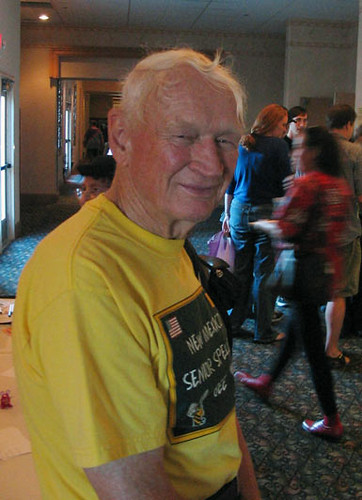
Robert Heinlein, L. Sprague de Camp, and Isaac Asimov, Philadelphia Navy Yard, 1944. Heinlein and Asimov were two of The Big Three. Who was the third?
Last weekend, Vox Day set out to score a point for Infogalactic over the Wikipedia. Infogalactic is the rival online encyclopedia Day launched in October.
…And finally, another example of how Infogalactic is fundamentally more accurate than Wikipedia due to the latter’s insistence on unreliable Reliable Sources.
Robert Heinlein on Wikipedia
Heinlein became one of the first science-fiction writers to break into mainstream magazines such as The Saturday Evening Post in the late 1940s. He was one of the best-selling science-fiction novelists for many decades, and he, Isaac Asimov, and Arthur C. Clarke are often considered the “Big Three” of science fiction authors.[5][6]
Robert Heinlein on Infogalactic
He was one of the first science fiction writers to break into mainstream magazines such as The Saturday Evening Post in the late 1940s. He was one of the best-selling science fiction novelists for many decades, and he, Isaac Asimov, and Arthur C. Clarke are often erroneously considered to be the “Big Three” of science fiction authors.[5][6]. The original “Big Three” were actually Heinlein, Asimov, and A.E. van Vogt.[7]
This is what winning the cultural war looks like. Getting the facts straight one at a time.
Since Vox Day’s post, an Infogalactic editor has revised the Heinlein entry to phrase the correction even more emphatically:
He was one of the best-selling science fiction novelists for many decades, and he, Isaac Asimov, and Arthur C. Clarke are often considered to be the “Big Three” of science fiction authors[5][6], however the inclusion of Clarke is erroneous. The original “Big Three” were actually Heinlein, Asimov, and A.E. van Vogt.[7]
Proving that you’re never too old to learn, while I knew Heinlein, Asimov and van Vogt were Campbell’s top writers in the 1940s, I couldn’t recall ever hearing them referred to as the Big Three, whereas I had often heard that term applied to the trio named by the Wikipedia. (Michael Moorcock wrote that Clarke was one of the Big Three in an article published just this month.) Was the Heinlein/Asimov/Clarke identification really “erroneous”? I have to admit that seeing Infogalactic’s cited source was a John C. Wright essay from 2014 made me want to check further before accepting the information.
Google led me to the Fancyclopedia (1944). Originally, “the Big Three” was a label 1930s fans applied to the three dominant prozines. Obviously at some later point they also endowed it on three sf writers. When did that happen, and who were the writers?
Isaac Asimov supplies the answer in I. Asimov: A Memoir (1994):
There was no question that by 1949 I was widely recognized as a major science fiction writer. Some felt I had joined Robert Heinlein and A.E. van Vogt as the three-legged stool on which science fiction now rested.
As it happened, A.E. van Vogt virtually ceased writing in 1950, perhaps because he grew increasingly interested in Hubbard’s dianetics. In 1946, however, a British writer, Arthur C. Clarke, began to write for ASF, and he, like Heinlein and van Vogt (but unlike me), was an instant hit.
By 1949, the first whisper of Heinlein, Clarke, and Asimov as “the Big Three” began to be heard, This kept up for some forty years, for we all stayed alive for decades and all remained in the science fiction field.
Therefore, John C. Wright (in “The Big Three of Science Fiction” from Transhuman and Subhuman: Essays on Science Fiction and Awful Truth) correctly stated that Heinlein, Asimov and van Vogt were “the three major writers of Campbell’s Golden Age.” (The Science Fiction Encyclopedia also calls them “the big three”.)
But Infogalactic, unfortunately motivated by a need to get in a jab at the Wikipedia, has oversold Wright’s argument and missed a chance to be really accurate. The truth is that both trios were “the Big Three,” each in their own era.

